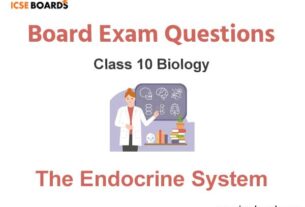Students should refer to Cell The Structural and Functional Unit of Life ICSE Class 10 Biology Board Exam Questions provided below with solutions. These will help the students to understand the type of questions which have been asked in previous year examinations and the type of solutions which the student should give to get good marks. You should also refer to ICSE Class 10 Biology Sample papers for more practice
ICSE Class 10 Biology Cell The Structural and Functional Unit of Life Important Questions
Students should learn the important questions and answers given below for Chapter Cell The Structural and Functional Unit of Life in Biology for ICSE Class 10. These board questions are expected to come in the upcoming exams. Students of ICSE Class 10th should go through the Important questions and answers ICSE Class 10 Biology which will help them to get more marks in exams.
Cell The Structural and Functional Unit of Life ICSE Class 10 Biology Board Exam Questions
Question: What are the characteristics of a cell organelle?
Ans. A cell organelle –
a. Is a membraned structure
b. Lies inside the protoplasm
c. Performs a specific function for the cell.
Question: Why are cells generally small in size?
Ans. Small size of the cell presents a large surface area to volume ratio.
The larger surface area of the cell ensures greater efficiency of the cell by providing.
a. large surface area for diffusion of nutrients.
b. greater diffusion of respiratory gases
c. easy repair to any damaged cell
Question: Drawn below is a diagram of a cell. Study the diagram and answer –

a. Label the parts marked 1 to 7.
Ans. 1. Cell Wall. 2. Cell membrane 3. Vacuole 4. Mitochondrion 5. Chloroplast 6. Nucleus 7. Golgi bodies
b. Is it a plant cell or an animal cell? State two reasons.
Ans. It is a plant cell. In plant cells, cell wall is present with a large vacuole whereas in animal cells, cell wall is absent with very few smaller vacuoles present.
c. State 2 differences between parts 1 and 2.
Ans.

d. State one functional activity of part 4 and 5 each.
Ans. Part 4 : In mitochondrion energy is produced in the form of ATP.
Part 5 : In chloroplast, sunlight is traped to produce food (Glucose).
Question: Drawn below is a diagram of a cell. Study the diagram and answer.

a. Label the parts marked 1 to 10.
Ans. 1. Cell membrane 2. Rough Endoplasmic reticulum
3. Smooth Endoplasmic reticulum 4. Centrioles
5. Mitochondria 6. Chromatin fibre.
7. Granules 8. Golgi body
9. Nucleus 10. Cytoplasm
b. Name the structure which is called –
Ans. a. Brain of the cell : Nucleus
b. Power-house of the cell : Mitochondria
c. Suicidal bag in a cell : Lysosomes
c. Is it a plant cell or an animal cell? Give 2 reasons.
Ans. It is an animal cell.
Reasons (i) cell wall is absent (ii) Do not contain plastids.
d. State the function of parts marked 1, 2 and 5.
Ans. 1. Cell membrane (plasma membrane) maintains shape of the cell ( in animal cells).
2. Rough endoplasmic reticulum helps in synthesis and transport of proteins and fats.
3. Mitochondria helps in release of energy from food in the form of ATP.
Question: Drawn below is the internal structure of a cell organelle. Study the diagram and
Ans..

a. Name the cell organelle.
Ans. Chloroplast.
b. What is the function of this cell organelle in a cell?
Ans. Chloroplast (green) trap solar energy for photosynthesis
c. Label the parts marked 1 to 6.
Ans. 1. Granum (in vertical section) 2. Stroma 3. Double membrane4. Thylakoids (Flattened sacs.) 5. Fret
Question: Name the Following :
Question: The organelle most vital for the survival of a cell.
Ans.
Nucleus
Question: Structural and functional unit of an organism.
Ans.
Cell
Question: Carbohydrate found as stored food in plant cell
Ans.
Starch
Question: A jelly like substance within a cell.
Ans.
Protoplasm
Question: The protein factories of a cell.
Ans.
Ribosomes
Question: Cell organelle which traps solar energy.
Ans.
Chloroplast
Question: Site of cellular respiration in a cell
Ans.
Mitochondrion
Question: An organelle associated with intra-cellular digestion.
Ans.
Lysosome
Question: A prokaryotic cell.
Ans.
Bacteria
Question: A polysaccharide found in the cell wall.
Ans.
Cellulose
Question: Cell organelle which provides supportive framework.
Ans.
Endoplasmic Reticulum
Question: Non-living rigid layer which gives shape to a cell.
Ans.
Cell wall
Question: The plastids found in the cells of yellow coloured petals.
Ans.
Chromoplast
Question: Carbohydrate found as stored food in an animal cell.
Ans.
Glycogen
Question: A red coloured pigment which imparts colour to carrots.
Ans.
Carotene
Question: A cell which does not have nuclear membrane
Ans.
Prokaryotic
Question: Minute holes in the nuclear membrane.
Ans.
Nuclear pores
Question: Rod shaped bodies that initiate cell division
Ans.
Centrioles
Question: A digestive enzymes found in the lysosomes.
Ans.
hydrolase
Question: Colourless plastids which store carbohydrates.
Ans.
Leucoplast
Question: Fill in the blanks with organelle-function association.
Question: _____________________________ inititation of cell division.
Ans.
Centrioles
Question: Nucleus and _____________________________.
Ans.
Control of metabolic activities
Question: Leucoplast and _____________________________.
Ans.
Storage of food
Question: _____________________________ and digestive enzymes.
Ans.
Lysosome
Question: _____________________________ and shape and rigidity to cell.
Ans.
Cell wall
Question: Ribosomes and ___________________________ .
Ans.
Protein synthesis
Question: _____________________________ and turgidity.
Ans.
Vacuole
Question: ______________________________ and cellular respiration.
Ans.
Mitochondrion
Question: Chloroplast and _____________________________.
Ans.
Photosynthesis
Question: _____________________________ and secretion of hormones and enzymes.
Ans.
Golgi complex
Question: State one example for each of the following :
Question: A Mammalian cell without a nucleus. _____________
Ans.
Mature RBC
Question: A secretory product in a plant cell. ______________
Ans.
Nectar/pigments
Question: A plant cell which is enucleated. _______________
Ans.
Sieve tube
Question: The single largest cell in the world. ________________
Ans.
Ostrich’s egg
Question: A Prokaryotic cell. _______________
Ans.
Bacteria/Blue green algae
Question: The longest cell in man. _______________
Ans.
Nerve cell
Question: A polysaccharide stored in an animal cell. ______________
Ans.
Glycogen
Question: Waste product in a plant cell. ________________
Ans.
gums/resin/latex.
Question: The smallest human cell. _________________
Ans.
Red Blood cell
Question: A polysaccharide found in plant cell wall. _______________
Ans.
Cellulose






